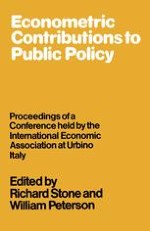1978 | Buch
Econometric Contributions to Public Policy
Proceedings of a Conference held by the International Economic Association at Urbino, Italy
herausgegeben von: Richard Stone, William Peterson
Verlag: Palgrave Macmillan UK
Buchreihe : International Economic Association Series
Enthalten in: Professional Book Archive
